Abstract
Background:
Nowadays, the demand for antibacterial fabrics has increased. White alum is used for oral aphthous ulcers treatment in traditional medicine of Sistan city, Sistan and Baluchistan Province, Iran, and also as a flocculent for water purification. This study is aimed to evaluate the effect of concentration and time on antibacterial activity of white alum on Escherichia coli O157:H7.
Materials and Methods:
0.25, 0.5, 1 and 2% concentrations of white alum were added to 108 CFU of Escherichia coli O157:H7. Optical Density was recorded for 4 hours. Data obtained were analyzed using Repeated Measure and One-way ANOVA by SPSS.
Results:
Results revealed the effectiveness of white alum in the growth of the tested bacterium. The white alum was found to be potent against Escherichia coli O157:H7 at a concentration above 1% (p<0.05). Also, its effect is dose and time dependent, as well as other disinfectants.
Conclusion:
A wide variety of natural products has been under scrutiny for their clinical potential, both in terms of prevention and treatment. Strong antibacterial activity of white alum compared with control was shown against tested bacterium. In conclusion, white alum can be used as an inhibitor of bacterial growth, especially for Escherichia coli O157:H7.
Keywords: Antibacterial activity, Escherichia coli O157:H7, Sistan, Steoptria Alon aloman alen, White alum
Introduction
It has been reported that of 121 anticancer drugs used today, 90 are derived from plants. In addition, 60% of new drugs introduced between 1981 and 2002 are plants derived (Prasad and Tyagi, 2015). Traditional medicines have been used for primary health care in Sistan, Sistan and Baluchistan Provinces of Iran (Naseri nia et al., 2013). There has been a remarkable rise of medicinal substances’ use, probably due to their local abundance, cultural significance and inexpensive procurement. An urgent need to develop national pharmacopoeia, monographs of medicinal materials, and national standards and guidelines has been emphasized. Few ethno-chemical knowledge studies have been carried out in the country in South of Iran, the Sistan, one of the ancient cities. Local population of Sistan still rely on traditional healers for their health care (Naserinia et al., 2013). In the last decade, traditional medicine in Iran is mostly well known by medicinal plants, while, in fact, traditional medicine also has covered substances produced by nature. Natural products have been used for a long time in treating human disease and they contain many constituents of therapeutic value. Natural products are environmentally safer, easily available and cheap (Osuala et al., 2009). Examples of such substances used for traditional medicine include mineral substances such as white alum (Attarnejad, 2007).
White alum or potash alum (Aluminum Potassium Sulfate), the crystallized double sulfates with the formula KAl(SO4). 12H2O, is generally odorless, colorless crystalline solids (Oneda et al., 1994) that turn white in air, which is used in food preservation and antiseptic for many preparation processes such as pickling and fermentation, and water purification as a flocculants (Bestoon, 2012). Moreover, alum has been recommended as category I active ingredient in mouthwashes by the Counter Advisory Panel of US Food and Drug Administration (Olmez et al., 1998). It is used as an astringent and successful in controlling profuse bleeding by ensuring effective blood clotting (Goswami et al., 1993). Aluminum Potassium Sulfate is entitled in Arabic, Greek and Indian as “Sheb, Kholel-ol-gheys, Paahtekri”, respectively. Native Persian population based on their local accent, call the Aluminum Potassium Sulfate as “zme (mashhad), zi (azarbayjan), zmej (Sistan)” (Attarnejad, 2007). zmej in Sistan is administerated by local healers for treatment of oral aphthous ulcers (Afshar, 2003; M, Golestaneh, Sistan and Bluchestan Cultural Heritage, Handcrafts and Tourism Organization, Iran, ‘personal communication,’ 2006). Escherichia coli (E. coli) is a Gram-negative, rod-shaped, facultative anaerobic bacterium. This microorganism was first described by Theodor Escherich in 1885. Most E. coli strains are harmless and colonize the gastrointestinal tract of humans and animals as normal flora (Lim et al., 2010). However, there are some strains that have evolved into pathogenic E. coli (Kaper et al., 2004). E. coli can be categorized based on serogroups, pathogenicity mechanisms, clinical symptoms, or virulence factors (Kaper et al., 2004). E. coli O157:H7 is one of thousands of serotypes of E. coli (Clark, 2016). Several serotypes in E. coli are frequently associated with human diseases such as O157:H7 (Paton and Paton, 1999). E. coli O157:H7 is a cause of disease, typically foodborne illness of the “colonic escherichiosis” type, through consumption of contaminated and raw food (Karch et al., 2005). E. coli O157:H7 was first recognized as a pathogen in 1982 during an investigation into an outbreak of hemorrhagic colitis associated with consumption of hamburgers from a fast food chain restaurant (Clark, 2016). Center for Disease Control and Prevention (CDC) has estimated that E. coli O157:H7 infections cause 73,000 illnesses, 2,200 hospitalizations, and 60 deaths annually in the United State (Mead et al., 1999). The use of antibiotics in the treatment of diseases can lead to emergence of antibiotic resistant bacterial strains. Hence, researchers are looking for alternatives with different origin to replace antibiotics (Chowdhury et al., 2006). Natural extracts can interfere in different fragments of the cell, including cell wall, cytoplasmic membrane, cytoplasmic membrane proteins. In addition, they could lead to coagulation, vacuolation or leakage of cytoplasmic contents and finally, growth inhibition of bacteria (Burt, 2004).
This study aimed to determine the effect of time and concentration on antibacterial activity of white alum against E. coli O157:H7 isolated from water, and also, to document the local knowledge of traditional medicines’ use by population in Sistan.
Materials and Methods
Study Area and Design
The present investigation was conducted as an in vitro experimental study. Sistan (30.5°N, 61°E), one of the ancient cities of Iran is located neighbor to the Shahr-i Sokhta (UNESCO World Heritage Centre 1992-2016). Its climate is hot and dry, and also affected by 120-day winds of Sistan in summer (Karimi et al., 2013).
Test organism
A gram negative microorganism was used for the test. The bacterial strain was isolated from water sources of Sistan and identified as E. coli O157:H7 in Microbiology Laboratory, Faculty of Veterinary Medicine, University of Zabol, Iran (Nazemi, 2015).
Preparation of different concentration of aqueous extracts
White alum was delivered from a local healer at Zabol city, Iran, and was identified in the Faculty of Veterinary Medicine, Department of basic sciences, University of Zabol. One gram of crystals of white alum KAl(SO4).12H2O dissolved completely in 50 ml warm Peptone Water (PW) broth (Difco) to prepare stock concentration of 100 mg/ml (2%) at pH7. The white alum stock solution was sterilized by filtration through a mili pore filter with a pore diameter of 0.45 μmol. All concentrations were prepared from stock solution in a sterile condition. Using PW, four concentrations of white alum, including 2, 1, 0.5 and 25 v/v % were prepared (Bahrami et al., 2009) and applied for in vitro study.
In Vitro Bioassays to Detect Antibacterial Activity
E. coli O157:H7 was inoculated in different concentrations of white alum (2, 1, 0.5, 0.25 v/v %) to determine the inhibitory effect of white alum on growth of E. coli O157:H7 (Table 1).
Table 1.
Detailed scheme used in present study
| Abbreviation | Definition | Code of Well |
|---|---|---|
| Z2+B | 100 ul of tested bacterium mixed with 100 μl of 2% white alum | 1 |
| Z1+B | 100 ul of tested bacterium mixed with 100 μl of 1% white alum | 2 |
| Z0.5+B | 100 ul of tested bacterium mixed with 100 μl of 0.5% white alum | 3 |
| Z0.25+B | 100 ul of tested bacterium mixed with 100 μl of 0.25% white alum | 4 |
| PW+B | 100 ul of tested bacterium mixed with 100 ul of fresh PW (growth control) | 5 |
| Z2+PW | 100 ul of 2% white alum mixed with 100 ul of fresh PW (control for 2% white alum) | 6 |
| Z1+PW | 100 ul of 1% white alum mixed with 100 ul of fresh PW (control for 1% white alum) | 7 |
| Z0.5+PW | 100 ul of 0.5% white alum mixed with 100 ul of fresh PW (control for 0.5% white alum) | 8 |
| Z0.25+PW | 100 ul of 0.25% white alum mixed with 100 ul of fresh PW (control for 0.25% white alum) | 9 |
| PW+PW | 100 ul of fresh PW mixed with 100 ul of fresh PW (culture medium control) | 10 |
Briefly, two hours culture of E. coli O157:H7, grown in 5 mL PW broth, were adjusted to 0.5 McFarland standard (108 CFU, confirmed by plate colony count). 100 μL of culture was dispensed into flat-bottomed 96-well microtiter plates and mixed with 100 μL of different concentration of white alum. The experiment was repeated using PW or PBS broth instead of white alum. Also, as alum control, 100 μL of PW was mixed with 100 μL of differrent concentrations of alum. Plates were incubated at 37 °C and the growth was monitored using a micro-plate reader set at 490 nm (Stat fax-2100, UK) every 30 min for 4 hr. All bioassays were performed in triplicates and the mean values calculated (Lamoochi and Safahieh, 2014).
Statistical analysis
The data were analyzed using Repeated Measures and One-way ANOVA for concentration and time course effects, respectively, by SPSS software (IBM, USA, 2007), and statistical difference was compared based on Fisher’s LSD test, at significance level of P<0.05.
Results
Different concentrations of white alum perform various roles on E. coli growth.
We assumed that the growth of E. coli O157:H7 incubated with higher concentration of white alum will lead to more decrease than lower concentration of alum. Latent assumption of our investigation was also to evaluate the effect of white alum on the growth of E. coli O157:H7. To answer the mentioned hypothesis, the Repeated Measures ANOVA test was applied and the results are shown in figure 1. Mean value of growth of E. coli mixed with different concentration of white alum for 4 hours, in comparison with control (PW+B), were not equivalent. Incubation of E. coli O157:H7 for 4 hours with different concentrations of white alum resulted in different growth of tested bacterium. The growth of the test organism remained unaffected in control tube (PW+B), and a dose-dependent decrease of growth of E. coli O157: H7 in white alum-treated culture was apparent. Our results demonstrate that the decrease of growth were statistically significant for 2% and 1% of white alum, and these two concentrations of white alum decreased the growth of E. coli O157:H7 remarkably, compared with control tube (p<0.05). No growth was observed in other control tubes (Z2+B, Z1+B, Z0.5+B, Z0.25+B, PW+PW) (Data was not shown).
Figure 1.
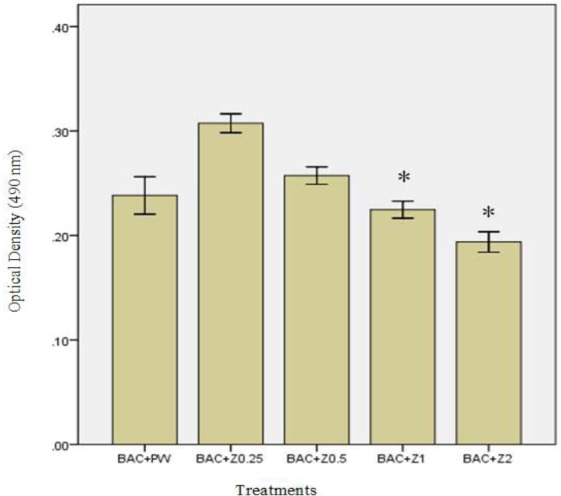
Growth of E. coli O157:H7 mixed with different concentrations of white alum during 4 hours. Error Bars display Confidence Interval for Mean. Asterisks indicate the signficance difference, compared with BAC+PW (p<0.05).
BAC+PW: tested bacterium incubated with pepton water broth; BAC+Z0.25: tested bacterium incubated with %0.25 white alum; BAC+Z0.5: tested bacterium incubated with %0.5 white alum, BAC+Z01: tested bacterium incubated with %1 white alum, BAC+Z2: tested bacterium incubated with %2 white alum.
The effect of white alum on the growth of E. coli is time-dependent.
Furthermore, we assessed the effect of time on growth of E. coli O157:H7 incubated with white alum. As seen in Figure 2, One-way ANOVA analysis showed that white alum played a time-dependent role on the growth of the test organism. Lower concentrations needed more time to react properly (Table 2). The growth of E. coli O157:H7 was decreased outstandingly at 3, 3 and 2.5 hours after incubation with alum concentrations of %0.5, %1 and %2, respectively (p<0.05), while the inhibitory effect of concentration of %0.25 of white alum on growth of E. coli O157:H7 continued until 2.5 hours after incubation. Thus, the time-dependent effect of white alum on E. coli O157:H7 growth was evident (Figure 2).
Figure 2.
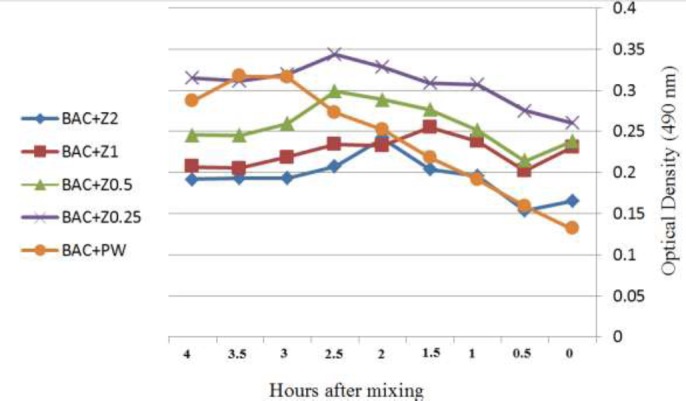
Growth of E. coli O157:H7 mixed with different concentrations of white alum after 0.5, 1, 1.5, 52, 2.5, 3, 3.5 and 4 hour. BAC+PW: tested bacterium incubated with pepton water broth; BAC+Z0.25: tested bacterium incubated with %0.25 white alum; BAC+Z0.5: tested bacterium incubated with %0.5 white alum, BAC+Z01: tested bacterium incubated with %1 white alum, BAC+Z2: tested bacterium incubated with %2 white alum.
Table 2.
Effect of time on growth of E. coli O157:H7 mixed with white alum in comparison with control (BAC+PW)
| Treatments | Time (Hours after mixing) | |||||||
|---|---|---|---|---|---|---|---|---|
| 0.5 | 1 | 1.5 | 2 | 2.5 | 3 | 3.5 | 4 | |
| BAC+Z0.25 vs BAC+PW | ■ | ■ | ■ | ■ | ■ | |||
| BAC+Z0.5 vs BAC+PW | ■ | ■ | ■ | ■ | ■ | ■ | ||
| BAC+Z1 vs BAC+PW | ■ | ■ | ||||||
| BAC+Z2 vs BAC+PW | ■ | ■ | ■ | ■ | ||||
The treatments that are significantly different (p<0.05) from each other at the same time point indicated by ■.
Figure 3.
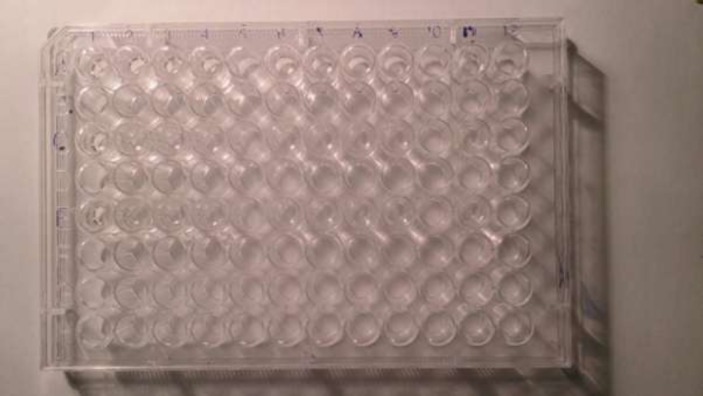
Microtitre plate at the outset of investigation loading with E. coli O157:H7 mixed with white alum. A, C and E rows represent the repetition; Column 5, 10 and 12 were remained empty to increase accuracy.
Figure 4.
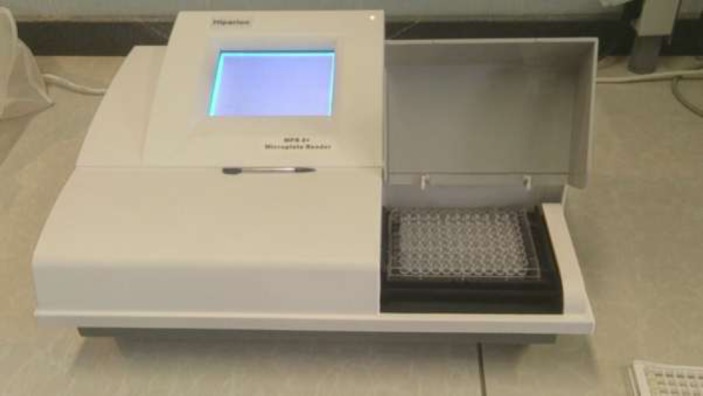
pectrophotometry of mixture of the tested bacterium and white alum in beginning of experiment.
Figure 5.
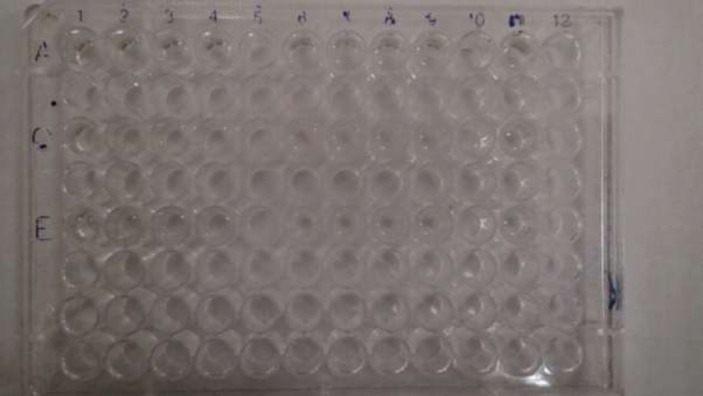
Microtitre plate after 4 hours.
Figure 6.
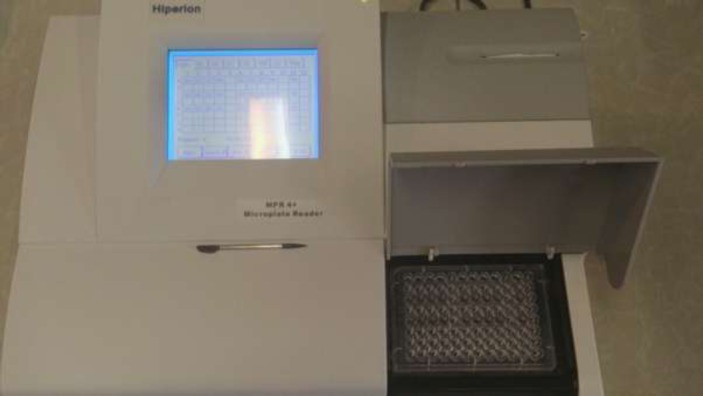
Spectrophotometry after 4 hours.
Discussion
Today, demands for the production of antimicrobial substances in health care have increased. Therefore, discovering a suitable material to introduce as a proper anti-bacterial agent has been considered as a challenge. Different materials such as quaternary ammonium compounds, metal nanoparticles oxidates, metal nanoparticles, and nanocomposites have been reported as antimicrobial agents (Rice, 1957). Excessive use of antibiotics can lead to emergence of antibiotic resistant bacterial strains. Thus, investigators are looking for other materials, such as substances of vegetative or mineral origin, to replace conventional anti-bacterial agents (Quinn et al., 2005). Non-biodegradable synthetic chemical compounds have been widely discussed as a choice to apply as an anti-microbial agent (Mirjalili and Abbasipour, 2013). A wide range of materials found in nature, have been considered in the treatment and control of diseases in clinical trials. Since ancient times, the materials made by nature, have been applied to treat human diseases. They are cheaper and more accessible. White alum is a mineral material and acts as an astringent and also, it plays a role as a disinfectant in different stages of food processing. It is known as a substance which eliminates undesirable colours and turbidity of the water (Oneda et al., 1994). Other objective of the present study was to collect information about the effect of different concentrations of white alum on E. coli O157:H7 growth.
There are scanty studies related to white alum. According to our literature review, the present study is the first report relating to the effect of different concentrations of white alum on Escherichia coli O157:H7 growth, isolated from water sources.
Bahrami et al (2009), conducted a study in Iran. They prepared two local formulates with local compound, including black and white alum. Their results showed that compound made of black and white alum, mixed with cupric sulfate and butter, was effective in the control of cutaneous leishmaniosis.
Ahmed (2011) studied the antibacterial activity of different concentrations of Alum (Hydrated Aluminum Potassium Sulfate) against Proteus mirabilis. They found that the following concentrations of white alum (0.0, 0.05, 0.1, 0.3, 0.5, 0.6, 0.7, 0.8, 0.9 mg/ ml) produced gradual effect on swarming of bacterium and concluded that alum has potential inhibitory effect against P. mirabilis. Our results are in consonance with their findings. Bnyan et al (2014) reported that alum has antibacterial effect. They examined different concentrations of alum by agar well diffusion method against four bacterial isolates including S. aureus, S. epidermidis, E. coli and Klebsiella pneumonia, and the results showed that 20% alum was considered as the MIC.
Cheong et al (2008) showed the antimicrobial activities of calcium ions and other cross-linking agents of alginate dressings, as well as their compatibility with commonly used topical antimicrobials. They suggested that copper, zinc and aluminium ions are more suitable cross-linking agents for alginate as they do not show antagonism with the antimicrobials, and could impart antimicrobial property to the resultant dressing. However, further studies in different physical condition should be conducted to find out the effect of white alum, as well as its toxicity. Previous studies showed that 0.3 and 0.6 mg/mL of alum have been used to filter potable water (Bratby, 2006). In addition, it has little toxicity on laboratory animals, and abrupt ingestion of 30 gr of alum will lead to kill a mature human (Mallinckreod chemical, 2009).
The results of the presented study demonstrated that 2% and 1% concentrations of white alum significantly lead to decrease in the growth of E. coli O157:H7, in vitro. The aqueous extract, as a proper medium, has mediated the biochemical activities of compounds, and also directed antimicrobial properties.
On the other hand, 0.5% and 0.25% concentrations of white alum have no significant effect on the growth of E. coli, although these concentrations have decreased the growth of E. coli. It indicates that the white alum effect is dose response, and greater concentration will lead to enhanced decrease on bacterial growth. Thus, we suggest that 1% and 2% concentrations of white alum could be used as a substitution, instead of hazard chemical conservator in drinking solutions, especially water. Further work is required to study the safety and long-term effects of white alum on human beings when used for decontamination of water. A value of 0.2 mg/l in drinking water is recommended by WHO based on aesthetic consideration (WHO, 1984). Careful operation of filtration or any other process is mandatory for successful treatment of water to obtain both an aesthetically acceptable product and effective disinfection (Dutta et al., 1996). Although the development of new active natural drugs requires integration of several sciences such as botany, chemistry and pharmacology, recording how a substance is used in folk medicine by an ethnic group is the major common strategy (Rates, 2001). In addition, ethnobotanical studies play an important role in the conservation and valorization of biological resources (Polat and Satil, 2012).
Results of this study showed that the time consumption will lead to more decrease of the growth of E. coli with white alum. It concluded that the activity of the studied substance, as well as other disinfectants, is related to time consumption. Inhibitory effect of higher concentrations were observed after 2 hours, while lower concentrations showed the inhibitory effect in the first three time points. It is indicated that the effect of alum is time-dependent and increasing the concentration will require more time to act.
In conclusion, white alum has anti-bacterial effect on E. coli O157:H7, and in vitro study of this substance demonstrated that its effect is dose-and time-dependent. Finally, 1% and 2% of concentrations of white alum decreased the growth of E. coli O157:H7, significantly.
List of Abbreviations: E. coli: Escherichia coli., CDC: Center for Disease Control and Prevention.
Acknowledgement
This study was performed in partial fulfillment of the requirements for a BSc in Laboratory Sciences student’s project (Reza Shahriari). We acknowledge the assistance provided by the staff of the laboratory of biochemistry and microbiology, especially, Mr. Saeed Shahriari.
References
- 1.Afshar (Sistani) I. Sistan traditional medicine. Zabol University Press; Zabol: 2003. p. 29. Text in Persian. [Google Scholar]
- 2.Ahmed KT. Inhibition of swarming in Proteus mirabilis by Alum (Hydrated Aluminum Potassium Sulfate) J Uni Anbar for pure science. 2011;5(2):175–178. [Google Scholar]
- 3.Attarnejad MH. Alum Quarterly Attar nameh. 2007;7:34–35. Text in Persian. [Google Scholar]
- 4.Bahrami AM, Khosravi A, Maspi N. Effects of Drug Combined of Black And White Alum on Cutaneous Leishmaniasis Lesion. Scie J of Ilam Uni Med Sci. 2009;17(4):53–60. Text in Persian. [Google Scholar]
- 5.Bestoon MF. Evidance for feasibility of aluminum potassium sulfate (alum) solution as a root canal irrigant. JBagh Coll Dent. 2012;24(1):1–5. [Google Scholar]
- 6.Bnyan I. A, Alta’ee AH, Kadhum NH. Antibacterial Activity of Aluminum Potassium Sulfate and Syzygium Aromaticum Extract Against Pathogenic Microorganisms. J Nat Sci Res. 2014;4(15):137–141. [Google Scholar]
- 7.Bratby J. Coagulation and flocculation in water and wastewater treatment. IWA Publications; London: 2006. p. 407. [Google Scholar]
- 8.Burt S. Essential Oils: Their Antibacterial Properties and Potentional Applications in Foods, a Review. Inter J Food Microbiol. 2004;94(3):223–253. doi: 10.1016/j.ijfoodmicro.2004.03.022. [DOI] [PubMed] [Google Scholar]
- 9.Dutta S, De SP, Bhattacharya SK. In vitro antimicrobial activity of potash alum. Indian J Med Res. 1996;104:157–9. [PubMed] [Google Scholar]
- 10.Cheong HG, Heng PWS, Huang EPE, Li BKH, Chan LW. Interactions of antimicrobial compounds with cross-linking agents of alginate dressings. J Antimicro Chemoth. 2008;62(1):105–108. doi: 10.1093/jac/dkn168. [DOI] [PubMed] [Google Scholar]
- 11.Chowdhury AI, Molla AI, Sarker M, Rana AA, Ray SK, Nur HP, Karim MM. Preparation of edible grade dye and pigments from natural source Bixa Orellenae Linn. Inter J Bas App Sci. 2006;10(4):7–22. [Google Scholar]
- 12.Clark M About E. coli. 2016 http://www.about-ecoli.com/ecoli_o157/#.WBEWlMndXIU .
- 13.Goswami AK, Mahajan RK, Nath R, Sharma SK. How safe is 1% ALUM irrigation in controlling intractable vesicle hemorrhage? J Urol. 1993;149(2):264–267. doi: 10.1016/s0022-5347(17)36051-2. [DOI] [PubMed] [Google Scholar]
- 14.Kaper JB, Nataro JP, Mobley HL. Pathogenic Escherichia coli. Nat Rev Microbiol. 2004;2(2):123–140. doi: 10.1038/nrmicro818. [DOI] [PubMed] [Google Scholar]
- 15.Karch H, Tarr P, Bielaszewska M. Enterohaemorrhagic Escherichia coli in human medicine. Int J Med Microbiol. 2005;295(6-7):405–18. doi: 10.1016/j.ijmm.2005.06.009. [DOI] [PubMed] [Google Scholar]
- 16.Karimi M, Yazdani MH, Naderi A. The effect of 120-day winds on the safety of Sistan region. Geog and Environ Plang J. 2013;50(2):25–28. Text in Persian. [Google Scholar]
- 17.Lamoochi R, Safahieh A. Effect of environmental factors of temperature, salinity and level of heavy metal lead on growth of lead resistant bacterium isolated from Persian Gulf sediments. J. Aqu. Eco. 2014;3(4):60–51. Text in persian. [Google Scholar]
- 18.Lim JY, Yoon J, Hovde CJ. A Brief Overview of Escherichia coli O157: H7 and Its Plasmid O157. J Microbiol Biotechnol. 2010;20(1):5–14. [PMC free article] [PubMed] [Google Scholar]
- 19.Mallinckreod chemical Material and safety Data Sheet (MSDS) Aluminum potassium sulfate. J. Bakr. Inc. USA. 2009 [Google Scholar]
- 20.Mead PS, Slutsker L, Dietz V, McCaig LF, Bresee JS, Shapiro C, Griffin PM, Tauxe RV. Food-related illness and death in the United States. Emerg Infect Dis. 1999;5(5):607–625. doi: 10.3201/eid0505.990502. [DOI] [PMC free article] [PubMed] [Google Scholar]
- 21.Mirjalili M, Abbasipour M. Comparison between antibacterial activity of some natural dyes and silver nanoparticles. J Nano Chemis. 2013;3:37. [Google Scholar]
- 22.Naserinia MH, Nazerian NM, Naserinia I. Survey on variety of common traditional treatments in Sistan and Baluchistan. J Islam and Iran Trad Med. 2013;4(1):55–66. (Text in Persian) [Google Scholar]
- 23.Nazemi K. DVM Thesis. University of Zabol; Zabol, Iran: 2015. The prevalence of E. coli and salmonella spp. isolated from water sources of Zabol. Text in Persian. [Google Scholar]
- 24.Olmez A, Can H, Ayhan H, Olur H. Effect of alum-containing mouthrins in children for plaque and salivary levels of selected oral microflora. J Clin Pediat Dent. 1998;22(4):335–341. [PubMed] [Google Scholar]
- 25.Oneda S, Takasaki T, Kuriwaki K, Ohi Y, Umekita Y, Hatanaka S, Fujiyoshi T, Yoshida A, Yoshida H. Chronic toxicity and tumorigenicity studyofaluminum potassium sulfate in B6C3F1mice In vivo. 1994;8(3):271–278. [PubMed] [Google Scholar]
- 26.Osuala FT, Ibidapo obo MT, Okoh HI, Aina OO, Igbasi UT, Nchiogu ME. Evaluation of the effecincy and safety of potassium aluminum tetra oxosuiphate in the treatment of tuberculosis. European J Biol Sci. 2009;1(1):10–14. [Google Scholar]
- 27.Paton A. W, Paton JC. Direct detection of Shiga toxigenic Escherichia coli strains belonging to serogroups O111, O157, and O113 by multiplex PCR J Clin Microbiol . 1999;37(10):3362–3365. doi: 10.1128/jcm.37.10.3362-3365.1999. [DOI] [PMC free article] [PubMed] [Google Scholar]
- 28.Polat R, Satil F. An ethnobotanical survey of medicinal plants in Edremit Gulf (Balikesir-Turkey) J Ethnopharmacol. 2012;139(2):626–41. doi: 10.1016/j.jep.2011.12.004. [DOI] [PubMed] [Google Scholar]
- 29.Prasad S, Tyagi AK. Traditional medicine: The goldmine for modern drugs. Adv Tech Biol Med. 2015;3(1):1–2. [Google Scholar]
- 30.Quinn PJ, Markey BK, Carter ME, Donnelly WJC, Leonar FC. Veterinary microbiology and microbial diseas. Blakwell Science Publication; USA: 2005. p. 400. [Google Scholar]
- 31.Rates SM. Plants as source of drugs Toxicon. 2001;39(5):603–13. doi: 10.1016/s0041-0101(00)00154-9. [DOI] [PubMed] [Google Scholar]
- 32.Rice JK. The use of organic flocculants and flocculating aids in the treatment of industrial water and industrial waste water. Symposium on Industrial Water and Industrial Waste Water 1957 [Google Scholar]
- 33.UNESCO World Heritage Centre 1992-2016. Shahr-i Sokhta. 2016 http://whc.unesco.org/en/list/1456 .
- 34.World Health Organisation Guidelines for Drinking-water Quality, Health criteria and other supporting information. WHO publcation; Geneva: 1984. pp. 249–52. [Google Scholar]


